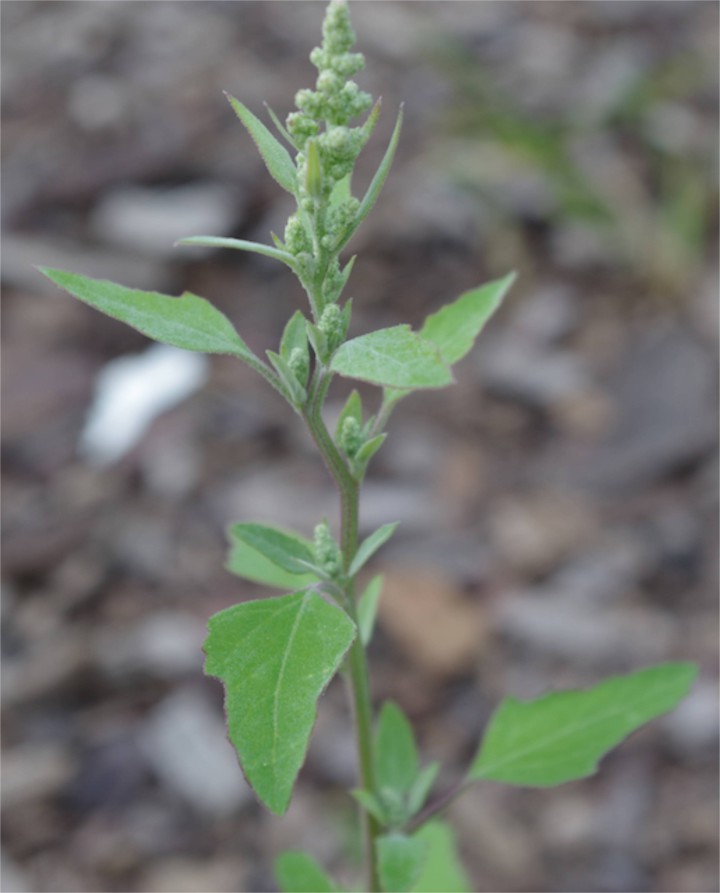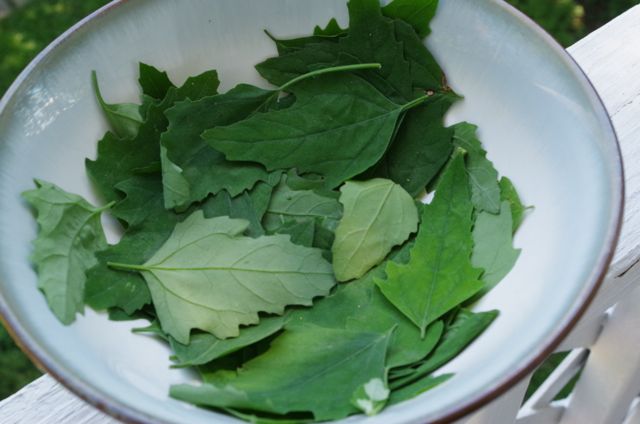When spring came to my Peace Corps village in Azerbaijan, fresh greens returned to the table after a winter of tasty but limited pickled vegetables. Small platters appeared piled with fresh sprigs of raw dill and cilantro, munched whole like asparagus spears or carrot sticks alongside the rest of the meal.
My host mother brought me to the edge of the yard one day and showed me some of the greens we could pick for dinner. One, called unnuca (oon-ooh-JAH), was so named because of the distinguishing whitish powder under the leaves. “Doesn’t it look like un?” my host mother asked. (Un is the Azerbaijani word for flour.)
Eight years later, outside my apartment in Asheville, I saw a small plant peeking up between rocks and wood chips. The jagged-edged, diamond-shaped leaves drew me in, and their powdery undersides only confirmed what my gut already knew — this was unnuca! The green I had picked for my host mother in Azerbaijan! Had it followed me here? Or did people in this part of the world know about it too?
It turns out I need not have traveled across the world to experience unnuca; once I discovered its English name, lambsquarters, I found out that it is one of the most bountiful wild edible greens in Western North Carolina.
Lambsquarters greens are like wild spinach — only, far more nutritious, with significantly more protein, vitamins C and A, and over three times as much calcium. I find them much tastier, too, with a satisfying earthiness reminiscent of mushrooms.
Lambsquarters seed is an older cousin of current health food superstar quinoa. According to Asheville wild foods tour company No Taste Like Home, it’s the most widely available edible wild seed in this area. “Until relatively recently,” says founder Alan Muskat, “lambsquarter, not corn, was the staple grain of North America. Domesticated at least 4,000 years ago, it would not be replaced by maize from Central America for 3,000 years. ”

In The Wild Wisdom of Weeds, Katrina Blair describes the potential usefulness of lambsquarter as “almost unlimited.” Among other things, Blair prepares quiche from lambsquarter greens, and in the spring, a detoxifying juice from the young leaves. Even the roots are useful, she writes, as they contain natural saponin detergent and can be used to make soap and shampoo.
It stands to reason that wild edible plants are better for us than agricultural produce, says Muskat, a renowned wild foods expert and educator. “We are evolved to eat wild food,” he says. “We’re designed to eat it. We’ve been eating it for millions of years.”
Muskat refers to the book Eating on the Wild Side by Jo Robinson, which presents evidence that cultivated varieties of fruits and vegetables are generally much lower in vitamins, minerals, phytonutrients and essential fatty acids than their wild counterparts. Robinson mentions lambsquarters directly in the book, saying it has been shown to fight viruses and bacteria, and was used by Native Americans to treat ailments as diverse as burns, stomachache and scurvy.
Once I realized what it was, I began seeing lambsquarters everywhere. On a jog in my neighborhood, I plucked a few of the plants from the side of a wooded area, and they easily took to my garden.
I recalled that in Azerbaijan, my host mother would sautée unnuca together with cilantro, dill, spinach, green onion and sometimes a little bit of nettles, with butter and salt. Sometimes, she would drop a couple of eggs into the pan near the end of the cooking time. Other times, she would stuff a large, thin, handmade dough circle with the greens mixture and fry it in a skillet like a delicious green quesadilla, to be brushed with melted butter.
In my host family’s yard, lambsquarters and nettles were not planted alongside dill and cilantro in the main garden but sprouted on their own on the side. They were valued, edible weeds, used mostly in the spring, when the leaves are more delicate.
Muskat says lambsquarters “epitomizes the gray area between wild and cultivated, because it has been cultivated for so long that they can’t even say where it’s ‘native.'” Despite his enthusiasm for wild foods in general, a terrible experience with kidney stones gives Muskat pause about eating too much lambsquarters due to its extremely high oxalic acid content (at 300,000 ppm, the highest of any plant measured), though he says that my Azerbaijani host mother’s method of pre-boiling the lambsquarters for a few minutes and discarding the water before adding other greens would make this much less of a concern.
Foraging, says, Muskat, is “a worldwide phenomenon that I think is only inevitable.” He points to Noma in Copenhagen, four times ranked the top restaurant in the world, which is focused entirely on wild food, as an example of how people are coming to realize that wild is often better. “To me, as a novelty,” he says of agriculture, “there’s a place for the plants that we’ve developed. But to say it in the extreme, it’s not that wild food is so good for you; it’s that anything else isn’t.”
Muskat assumes we can’t all go foraging, however, so he sees a slightly more managed solution: permaculture, a systematical blend of agriculture and foraging that involves working in partnership with nature to grow what would already thrive in an area without human assistance.
Like lambsquarters, dandelion, purslane, violets and nettles are impressively nutritious and abundant here, but are more often considered weeds than superfoods. As with so many other wild edibles, they’re ironically overlooked and undervalued — until they’re on your plate at an expensive restaurant. “You can command surprisingly high prices for something that is free and for many people is a weed,” says Muskat, who sold to restaurants for many years, “because of our collective ignorance and alienation and disempowerment.”
According to Muskat, foraging teaches us that we live in a Garden of Eden, that we don’t need to struggle so much to obtain what we need. Muskat has used foraging as a return to home in his personal life, and his goal now in wild foods education is to help others feel at home in this life, too. “It’s a choice we’ve made, we make every day,” he says, “to take what’s freely given as a gift, or to struggle to do it ourselves, to replace it with what we think is better.”
I recall that back in my Azerbaijani village, some of my best experiences were in house and garden work: collecting grape leaves, husking hazelnuts, learning to roll dough. Feeling physically connected with the network of substances that surrounded and supported me. By looking around and valuing and making use of what is here in WNC, I’m beginning to realize I can gain this sense of connection and belonging wherever I am.
Just think: You can burn fossil fuels to drive your car to the supermarket, pay $4.99 for a plastic (more fossil fuels) tub of baby spinach, or take a stroll outside your front door in the fresh air and sunshine, stretching your legs a bit to gather lambsquarter.
I know which one I’m going for. Which will you choose?
This story was originally published on Carla Seidl’s website, Earth Flavors.



What a great and informative article! Thank you!